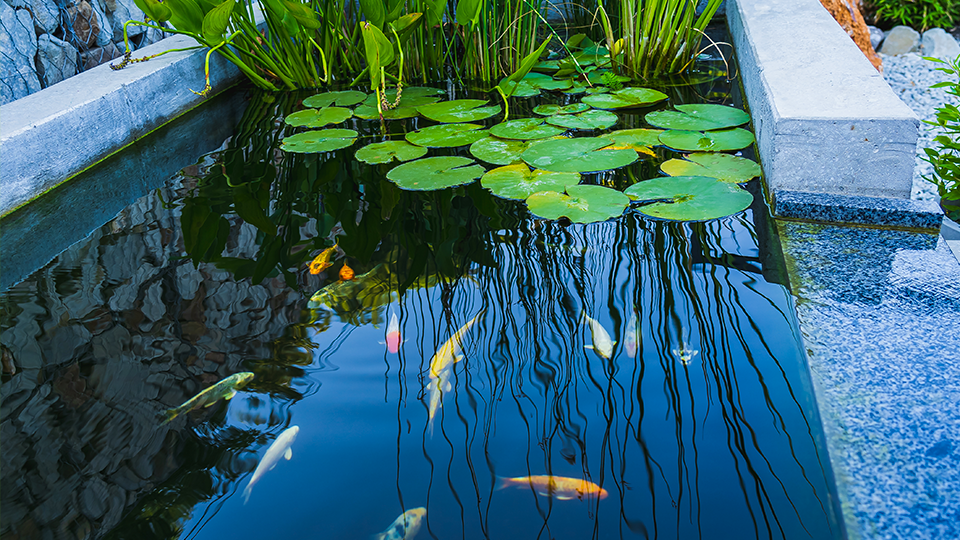Pond oxygenation is a key issue for anyone who looks after a body of water. Whether it is a small outdoor fish pond, a reservoir or a lagoon, in this article we will show you how to keep the oxygen level of the water high.
Why is oxygenation important?
Oxygen is a key component of aquatic life. Most living creatures are aerobic and therefore need oxygen for their metabolic processes.
In closed habitats, such as a pond, oxygen is scarce. Therefore, living creatures are always competing with each other to get it enough.
When oxygen is constantly in short supply, the ecosystem goes into a state of alarm: if oxygen is not replenished, the level of oxygen will tend to fall, while the needs of living beings remain unchanged. A vicious circle begins, with a constant decrease in oxygen. The result is a progressive degeneration of the habitat, which loses its biodiversity and becomes increasingly hostile to most life forms.
This is why it is very important to maintain a good level of oxygenation when managing a pond.
Oxygenation of ponds
Henry's law
The main principle of pond oxygenation is expressed by Henry's law:
"A gas which exerts pressure on the surface of a liquid will dissolve until it has reached the same pressure in that liquid as it exerts above it."
It means that the more the surface of the water is in contact with air, the more likely is the water oxygenation.
- Running water oxygenates more easily than still water. Mirrors of water with jumps, waterfalls and other movement systems have better oxygenation than static mirrors of water.
- A horizontally developed body of water tends to oxygenate more than a vertically developed body of water. Thus, wide, shallow bodies of water oxygenate more easily than narrow, deep bodies of water.
- Ponds with a large vegetation cover have more problems with oxygenation, as floating leaves limit oxygen exchanges between water and air.
Consequently, Henry's law presents us with some practical problems.
- For large bodies of water, create water movement with waterfalls or jumps is impossible or very expensive. In any case, it is not certain that oxygenation would be sufficient.
- Increase the surface area of a body of water is not possible without deep environmental modifications.
- The removal of plant cover often conflicts with the purpose of the pond. This is the case with ornamental lakes where water lilies and other water flowers are grown.
When the water surface is not enough to ensure oxygenation, an additional surface area can be added artificially using a special tool...
The ingenious system of bubble oxygenation
The bubble oxygenator is a device that collects ambient air and expels it below the surface of the lake.
The underwater release of air creates air bubbles. This is the ideal condition to exploit Henry's law. In fact, the bubble is a sphere of air with a surface 100% exposed to water. In this way it’s possible to maximize the dissolution of oxygen in water.
This oxygenation system makes possible to supply enough oxygen to sustain the pond ecosystem.
Vertical oxygenation
Vertical oxygenation is produced by disc diffusers that are installed at the bottom of the lake and expel air in small bubbles.
When switched on, they create a column of fine bubbles from the bottom to the surface. This is the perfect solution for deep ponds with little surface area in relation to their depth. The higher the column, the more water and air remain in contact. Consequently, better is the oxygenation.
Eco-Kit is the solution developed by Geotierre that combines a NewAir type disc diffuser and a pumping system.
The choice of NewAir for this activity is mainly due to 2 technical factors:
- It doesn’t release any toxic components. It is certified as suitable for use with drinking water. It is therefore ideal for supporting a pond populated by fish, turtles, dragonflies and other aquatic creatures, but also for breeding fish for human consumption.
- The high O2 yield makes it perfect for deep, fast and efficient oxygenation.
Horizontal oxygenation
For large but shallow lagoons and ponds, the most productive oxygenation system involves a horizontal flow of air bubbles. This system helps to keep the water moving, promoting natural oxygenation through ripples on the surface of the lake. In addition, the movement helps to lift debris from the bottom, preventing the formation of stagnation that encourages the proliferation of anaerobic bacteria.
The result is cleaner and clearer water, creating a favourable environment to sustain the ecosystem.
An apparatus of this type has been developed by an Australian company that has chosen Geotierre to supply tube aerators as air bubble release components.
Like its disc diffuser counterpart, the Newair tube diffuser is certified for use in drinking water. It does not release pollutants into the environment and is highly productive. Standard tube lengths range from 500 to 750 mm, but other lengths are available on request.
Learn more about Newair tubular diffuser
If you have any doubts and want to find your way around the field of bubble diffusers, ask Geotierre. We will be happy to give you all the information you need to oxygenate your pond!
